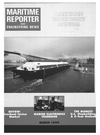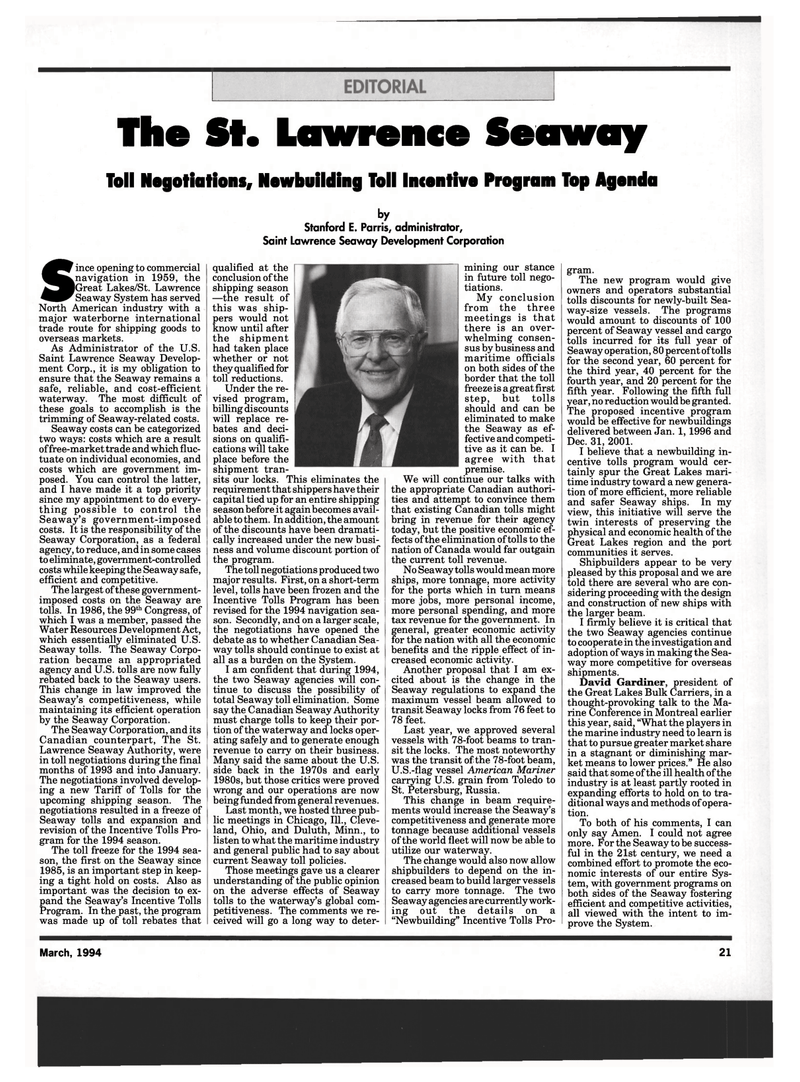
Page 19: of Maritime Reporter Magazine (March 1994)
Read this page in Pdf, Flash or Html5 edition of March 1994 Maritime Reporter Magazine
The St. Lawrence Seaway
Toll Negotiations, Newbuilding Toll Incentive Program Top Agenda by
Stanford E. Parris, administrator,
Saint Lawrence Seaway Development Corporation
Since opening to commercial navigation in 1959, the Great Lakes/St. Lawrence Seaway System has served North American industry with a major waterborne international trade route for shipping goods to overseas markets.
As Administrator of the U.S.
Saint Lawrence Seaway Develop- ment Corp., it is my obligation to ensure that the Seaway remains a safe, reliable, and cost-efficient waterway. The most difficult of these goals to accomplish is the trimming of Seaway-related costs.
Seaway costs can be categorized two ways: costs which are a result of free-market trade and which fluc- tuate on individual economies, and costs which are government im- posed. You can control the latter, and I have made it a top priority since my appointment to do every- thing possible to control the
Seaway's government-imposed costs. It is the responsibility of the
Seaway Corporation, as a federal agency, to reduce, and in some cases to eliminate, government-controlled costs while keeping the Seaway safe, efficient and competitive.
The largest of these government- imposed costs on the Seaway are tolls. In 1986, the 99th Congress, of which I was a member, passed the
Water Resources Development Act, which essentially eliminated U.S.
Seaway tolls. The Seaway Corpo- ration became an appropriated agency and U.S. tolls are now fully rebated back to the Seaway users.
This change in law improved the
Seaway's competitiveness, while maintaining its efficient operation by the Seaway Corporation.
The Seaway Corporation, and its
Canadian counterpart, The St.
Lawrence Seaway Authority, were in toll negotiations during the final months of 1993 and into January.
The negotiations involved develop- ing a new Tariff of Tolls for the upcoming shipping season. The negotiations resulted in a freeze of
Seaway tolls and expansion and revision of the Incentive Tolls Pro- gram for the 1994 season.
The toll freeze for the 1994 sea- son, the first on the Seaway since 1985, is an important step in keep- ing a tight hold on costs. Also as important was the decision to ex- pand the Seaway's Incentive Tolls
Program. In the past, the program was made up of toll rebates that qualified at the conclusion of the shipping season —the result of this was ship- pers would not know until after the shipment had taken place whether or not they qualified for toll reductions.
Under the re- vised program, billing discounts will replace re- bates and deci- sions on qualifi- cations will take place before the shipment tran- sits our locks. This eliminates the requirement that shippers have their capital tied up for an entire shipping season before it again becomes avail- able to them. In addition, the amount of the discounts have been dramati- cally increased under the new busi- ness and volume discount portion of the program.
The toll negotiations produced two major results. First, on a short-term level, tolls have been frozen and the
Incentive Tolls Program has been revised for the 1994 navigation sea- son. Secondly, and on a larger scale, the negotiations have opened the debate as to whether Canadian Sea- way tolls should continue to exist at all as a burden on the System.
I am confident that during 1994, the two Seaway agencies will con- tinue to discuss the possibility of total Seaway toll elimination. Some say the Canadian Seaway Authority must charge tolls to keep their por- tion of the waterway and locks oper- ating safely and to generate enough revenue to carry on their business.
Many said the same about the U.S. side back in the 1970s and early 1980s, but those critics were proved wrong and our operations are now being funded from general revenues.
Last month, we hosted three pub- lic meetings in Chicago, 111., Cleve- land, Ohio, and Duluth, Minn., to listen to what the maritime industry and general public had to say about current Seaway toll policies.
Those meetings gave us a clearer understanding of the public opinion on the adverse effects of Seaway tolls to the waterway's global com- petitiveness. The comments we re- ceived will go a long way to deter- mining our stance in future toll nego- tiations.
My conclusion from the three meetings is that there is an over- whelming consen- sus by business and maritime officials on both sides of the border that the toll freeze is a great first step, but tolls should and can be eliminated to make the Seaway as ef- fective and competi- tive as it can be. I agree with that premise.
We will continue our talks with the appropriate Canadian authori- ties and attempt to convince them that existing Canadian tolls might bring in revenue for their agency today, but the positive economic ef- fects of the elimination of tolls to the nation of Canada would far outgain the current toll revenue.
No Seaway tolls would mean more ships, more tonnage, more activity for the ports which in turn means more jobs, more personal income, more personal spending, and more tax revenue for the government. In general, greater economic activity for the nation with all the economic benefits and the ripple effect of in- creased economic activity.
Another proposal that I am ex- cited about is the change in the
Seaway regulations to expand the maximum vessel beam allowed to transit Seaway locks from 76 feet to 78 feet.
Last year, we approved several vessels with 78-foot beams to tran- sit the locks. The most noteworthy was the transit of the 78-foot beam,
U.S.-flag vessel American Mariner carrying U.S. grain from Toledo to
St. Petersburg, Russia.
This change in beam require- ments would increase the Seaway's competitiveness and generate more tonnage because additional vessels of the world fleet will now be able to utilize our waterway.
The change would also now allow shipbuilders to depend on the in- creased beam to build larger vessels to carry more tonnage. The two
Seaway agencies are currently work- ing out the details on a "Newbuilding" Incentive Tolls Pro- gram.
The new program would give owners and operators substantial tolls discounts for newly-built Sea- way-size vessels. The programs would amount to discounts of 100 percent of Seaway vessel and cargo tolls incurred for its full year of
Seaway operation, 80 percent of tolls for the second year, 60 percent for the third year, 40 percent for the fourth year, and 20 percent for the fifth year. Following the fifth full year, no reduction would be granted.
The proposed incentive program would be effective for newbuildings delivered between Jan. 1, 1996 and
Dec. 31, 2001.
I believe that a newbuilding in- centive tolls program would cer- tainly spur the Great Lakes mari- time industry toward a new genera- tion of more efficient, more reliable and safer Seaway ships. In my view, this initiative will serve the twin interests of preserving the physical and economic health of the
Great Lakes region and the port communities it serves.
Shipbuilders appear to be very pleased by this proposal and we are told there are several who are con- sidering proceeding with the design and construction of new ships with the larger beam.
I firmly believe it is critical that the two Seaway agencies continue to cooperate in the investigation and adoption of ways in making the Sea- way more competitive for overseas shipments.
David Gardiner, president of the Great Lakes Bulk Carriers, in a thought-provoking talk to the Ma- rine Conference in Montreal earlier this year, said, "What the players in the marine industry need to learn is that to pursue greater market share in a stagnant or diminishing mar- ket means to lower prices." He also said that some of the ill health of the industry is at least partly rooted in expanding efforts to hold on to tra- ditional ways and methods of opera- tion.
To both of his comments, I can only say Amen. I could not agree more. For the Seaway to be success- ful in the 21st century, we need a combined effort to promote the eco- nomic interests of our entire Sys- tem, with government programs on both sides of the Seaway fostering efficient and competitive activities, all viewed with the intent to im- prove the System.
March, 1994 21

 18
18

 20
20
